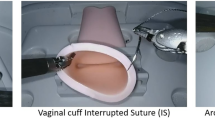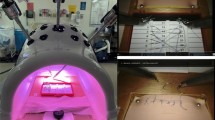Abstract
Introduction
The clinical application of robotic surgery is increasing. The skills necessary to perform robotic surgery are unique from those required in open and laparoscopic surgery. A validated laparoscopic surgical skills curriculum (Fundamentals of Laparoscopic Surgery or FLS™) has transformed the way surgeons acquire laparoscopic skills. There is a need for a similar skills training and assessment tool for robotic surgery. Our research group previously developed and validated a robotic training curriculum in a virtual reality (VR) simulator. We hypothesized that novice robotic surgeons could achieve proficiency levels defined by more experienced robotic surgeons on the VR robotic curriculum, and that this would result in improved performance on the actual daVinci Surgical System™.
Methods
25 medical students with no prior robotic surgery experience were recruited. Prior to VR training, subjects performed 2 FLS tasks 3 times each (Peg Transfer, Intracorporeal Knot Tying) using the daVinci Surgical System™ docked to a video trainer box. Task performance for the FLS tasks was scored objectively. Subjects then practiced on the VR simulator (daVinci Skills Simulator) until proficiency levels on all 5 tasks were achieved before completing a post-training assessment of the 2 FLS tasks on the daVinci Surgical System™ in the video trainer box.
Results
All subjects to complete the study (1 dropped out) reached proficiency levels on all VR tasks in an average of 71 (± 21.7) attempts, accumulating 164.3 (± 55.7) minutes of console training time. There was a significant improvement in performance on the robotic FLS tasks following completion of the VR training curriculum.
Conclusions
Novice robotic surgeons are able to attain proficiency levels on a VR simulator. This leads to improved performance in the daVinci surgical platform on simulated tasks. Training to proficiency on a VR robotic surgery simulator is an efficient and viable method for acquiring robotic surgical skills.
Similar content being viewed by others
References
Kenngott HG, Fischer L, Nickel F, Rom J, Rassweiler J, Müller-Stich BP (2012) Status of robotic assistance—a less traumatic and more accurate minimally invasive surgery? Langenbecks Arch Surg 397(3):333–341
Annual report 2010 (2011) Intuitive Surgical Inc.
Callery MP, Strasberg SM, Soper NJ (1996) Complications of laparoscopic general surgery. Gastrointest Endosc Clin N Am 6(2):423–444
Fried GM (2008) FLS assessment of competency using simulated laparoscopic tasks. J Gastrointest Surg 12(2):210–212
Sroka G, Feldman LS, Vassiliou MC, Kaneva PA, Fayez R, Fried GM (2010) Fundamentals of laparoscopic surgery simulator training to proficiency improves laparoscopic performance in the operating room-a randomized controlled trial. Am J Surg 199(1):115–120
Connolly M, Seligman J, Page M, Kastenmeier A, Goldblatt M, Gould JC (2014) Validation of a virtual reality based robotic surgical skills curriculum. Surg Endosc 28(5):1691–1694
Gallagher AG, Ritter EM, Satava RM (2003) Fundamental principles of validation, and reliability: rigorous science for the assessment of surgical education and training. Surg Endosc 17:1525–1529
Fraser SA, Klassen DR, Feldman LS, Ghitulescu GA, Stanbridge D, Fried GM (2003) Evaluating laparoscopic skills: setting the pass/fail score for the MISTELS system. Surg Endosc 17:964–967
Herron DM, Marohn M, SAGES-MIRA Robotic Surgery Consensus Group (2008) A consensus document on robotic surgery. Surg Endosc 22(2):313–325
Perrenot C, Perez M, Nguyen T et al (2012) The virtual reality simulator dV-Trainer is a valid assessment tool for robotic surgical skills. Surg Endosc 26:2587–2593
Kenney PA, Wszolek MF, Gould JJ, Libertino JA, Moinzadeh A (2009) Face, content, and construct validity of dV-Trainer: a novel virtual reality simulator for robotic surgery. Urology 73(6):1288–1292
Sethi AS, Peine WJ, Mohammadi Y, Sundaram CP (2009) Validation of a novel virtual reality robotic simulator. J Endourol 23(3):503–508
Lendvay TS, Casale P, Sweet R, Peters C (2008) VR robotic surgery: randomized blinded study of the dV-Trainer robotic simulator. Stud Health Technol Inform 132:242–244
Hung AJ, Zehnder P, Patil MB et al (2011) Face, content and construct validity of a novel robotic surgery simulator. J Urol 186:1019–1025
Arain NA, Dulan G, Hogg DC et al (2012) Comprehensive proficiency-based inanimate training for robotic surgery: reliability, feasibility, and educational benefit. Surg Endosc 26:2740–2745
Dulan G, Rege RV, Hogg DC et al (2012) Proficiency-based training for robotic surgery: construct validity, workload, and expert levels for nine inanimate exercises. Surg Endosc 26:1516–1521
Lerner MA, Ayalew M, Peine WJ, Sundaram CP (2010) Does training on a virtual reality robotic simulator improve performance on the da vinci surgical system? J Endourol 24(3):47–72
Goova MT, Hollett LA, Tesfay ST et al (2008) Implementation, construct validity and benefit of a proficiency based knot-tying and suturing curriculum. J Surg Educ 65:309–315
Mashaud LB, Castellvi AO, Hollett LA, Hogg DC, Tesfay ST, Scott DJ (2010) Two-year skill retention and certification exam performance after fundamentals of laparoscopic skills training and proficiency maintenance. Surgery 2:194–201
Gauger PG, Hauge LS, Andreatta PB (2010) Laparoscopic simulation training with proficiency targets improves practice and performance of novice surgeons. Am J Surg 199:72–80
O’Donnell RD, Eggemeier FT (1986) Workload assessment methodology. In: Boff KR, Kaufman L, Thomas JP (eds) Handbook of perception and performance, Vol 2, vol 42., Cognitive processes and performanceNew York, Wile, pp 1–49
Carswell CM, Clarke D, Seales WB (2005) Assessing mental workload during laparoscopic surgery. Surg Innov 12:80–90
Yurko YY, Scerbo MW, Prabhu AS, Acker CE, Stefanidis D (2010) Higher mental workload is associated with poorer laparoscopic performance as measured by the NASA-TLX Tool. Sim Healthc 5:267–271
Stefanidis D, Korndorffer JR Jr, Markley S, Sierra R, Heniford BT, Scott DJ (2007) Closing the gap in operative performance between novices and experts: does harder mean better for laparoscopic simulator training? J Am Coll Surg 205:307–313
Wetzel CM, Kneebone RL, Woloshynowych M et al (2006) The effects of stress on surgical performance. Am J Surg 191:5–10
Tanner L (2013) Robot hot among surgeons but FDA taking a fresh look. Available at: http://bigstory.ap.org/article/robot-hot-among-surgeons-fda-taking-new-look, 9 Apr 2013, Accessed 9 Aug 2013
Cooper MA, Ibrahim A, Lyu H, Makary MA (2013) Underreporting of Robotic Surgery Complications. J Healthc Qual; Aug 27, [epub ahead of print] PMID 23980819
Acknowledgments
The authors would like to acknowledge Dario Icardi, Robotic Specialist for Froedtert Hospital. We would also like to acknowledge Froedtert Memorial Lutheran Hospital, Milwaukee, WI and the Medical College of Wisconsin Department of Surgery, Division of General Surgery for their generous support of this project. Funding provided by the Medical College of Wisconsin Department of Surgery, Division of General Surgery.
Disclosures
Dr. Kastenmeier, Justin Bric, and Michael Connolly have no conflicts of interest or financial ties to disclose. Dr. Gould is a consultant for Torax Medical. Dr. Goldblatt receives funding support for research from WL Gore and Davol Inc. He is also a speaker for Covidien.
Author information
Authors and Affiliations
Corresponding author
Rights and permissions
About this article
Cite this article
Bric, J., Connolly, M., Kastenmeier, A. et al. Proficiency training on a virtual reality robotic surgical skills curriculum. Surg Endosc 28, 3343–3348 (2014). https://doi.org/10.1007/s00464-014-3624-5
Received:
Accepted:
Published:
Issue Date:
DOI: https://doi.org/10.1007/s00464-014-3624-5




